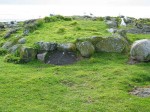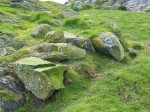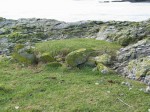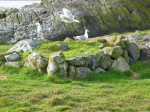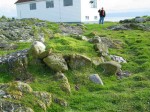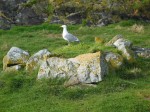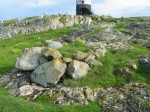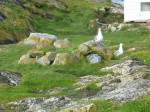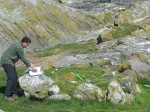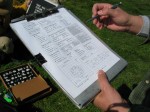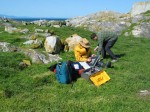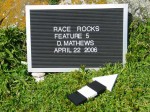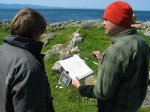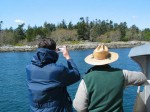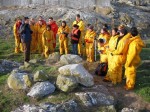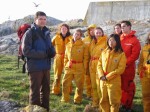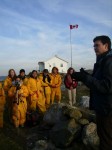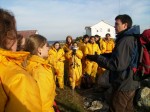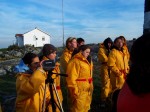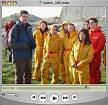The configuration of the rocks in several stone mounds at Race Rocks are suggestive of First Nations use of this area for burials in the period AD 500. Investigation into sites on the lower part of Vancouver Island, have shown that over 400 such sites exist on the nearby Rocky Point area.
These sites have recently been the subject of a Master’s thesis by Darcy Mathews of the Anthropology Department, University of Victoria.
- Rock cairn #1 April 2006
- cairn #2 can be seen using the remote camera 1
- Rock cairn #3
- Rock cairn #4
- Rock cairn #5
- Rock cairn #6
- Rock cairn #7 North side view
- Rock cairn #7 south side view
- The label board is prepared for photography of the cairn.
- Rock cairn #8 south side view
- April 26, 2006, Darcy Mathews records the details of the boulder configuration of one cairn. Precise measurements of distances and boulder size and composition are taken.
- The comprehensive data record form which Darcy uses in the field to record infomation which willl be entered in his database.
- The label board is prepared for photography of the cairn.
- A sign for identification of the cairns in the photos.
- Darcy explaining the process to the resident MPA guardian, Mike Slater.
- Darcy and Pete look at the shore of Rocky Point where over 400 burial cairns,which they have documented are located.
 View from the top of the science centre. If you click on this it will show a very large scale panorama of the site. Images taken and assembled by Garry Fletcher
View from the top of the science centre. If you click on this it will show a very large scale panorama of the site. Images taken and assembled by Garry Fletcher
Further background Information on Burial Cairn research .
The following is contact information on Darcy Mathews
(MA Candidate) University of Victoria, Department of Anthropology
Supervisor: Quentin Mackie
Topical Areas of Interest: Burial cairns, mortuary theory and monumentality, social identity, wetsite archaeology, Culture history of the Northern Strait of Georgia Geographical Areas of Interest: Greater Victoria, the northern Strait of Georgia
Working Title of Thesis: The Late Prehistoric Mortuary Landscape of Southern Vancouver Island”
Abstract:
In the southern Strait of Georgia, the symbolism employed in burial practices changed significantly between the Marpole and Late Prehistoric Periods, with flexed midden burials replaced by interments in cairns and mounds. I hypothesize that the new arrangement and use of mortuary space is the material expression of emerging social structures and possibly the concept of a shared Straits Salish identity-a process that is archaeologically visible at the regional, local, and site-specific levels. To explore the multifaceted role of burial cairns as a shared and mutually understood means by which peoples constructed, maintained, and contested social structure, I am employing a multi-scalar analysis of cairn distribution. The three scales of analysis include the macro distribution of cairn sites in the Strait of Georgia, the location of cairn sites within three sample landscapes in Greater Victoria, and the layout and structure of individual cairns within DbRv-3, a very large cairn site at Rocky Point in Metchosin.
Download the PDF for Burial Cairn Taxonomy and the Mortuary Landscape of Rocky Point, British Columbia (302 pages)
- Darcy Mathews explains his findings on the burial cairns to the Anthropology Class from Lester B.Pearson College
- Darcy and students
- Marin does the video on Darcy
 In January 2024 these burial cairns were added to the Megalithic Portal
In January 2024 these burial cairns were added to the Megalithic Portal
